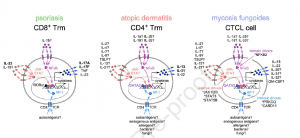T-cells, which play a key role in the adaptive immune response, are involved in many benign and malignant diseases, particularly in cutaneous (skin) infections.
Inflammatory skin disease (ISD) and cutaneous lymphoma disease (CTCL) are two types of cutaneous pathologies with strong clinical, epidemiological and genetic similarities. T-cells play an integral role in the pathophysiology of both diseases.
Studies found that ISD may lead to cancer or a malignant process such as non-Hodgkin’s lymphoma. Researchers today are still trying to understand how this disease is linked to the plasticity of T cells (malignant T-cells) and their pathological mechanisms.
Resident memory T-cells are said to be implicated in immune mechanisms of the skin and have been implicated in acute, chronic and malignant skin disease. Understanding these mechanisms and their origin may offer therapeutic approach/option for benign and severe skin disease.
Recent studies showed that ISD and CTCL is conditioned by TCR repertoire, thus TH2 cytokines appear to be a malignant marker of CTCL evolution.
Roediger, et al., suggested that the role of T cells, particularly due to their implication in the TH2 phenotype, in ISD disease could be a therapeutic avenue which can extend to CTCL (Figure 1). This is due to similarities in skin histopathology, observed alongside a TH2 phenotype.

Figure 1: Signaling pathways that regulate inflammatory cytokine production by pathogenic and malignant T cells in ISD and CTCL. Cytokine expression is controlled by signaling through NF-kB inducers (magenta), the JAK-STAT pathways (red), and via TCR signaling (light blue). In CTCL, mutations within these pathways bypass the requirement for external signals.
ISD such as atopic dermatitis showed that the TH2 cytokine blockade might offer a possible avenue for disease regression and skin environment modification, these results might extend to CTCL and offer new therapeutic perspectives. The researchers stated that it is necessary to investigate biomarkers of CTCL like those found in Atopic dermatitis despite these biomarkers not been used for diagnosis.
Journal article: Roediger, B., et al., 2022. T cells in the skin: lymphoma and inflammatory 1 skin disease. Journal of Allergy and Clinical Immunology.
Summary by Frederic Diaz










